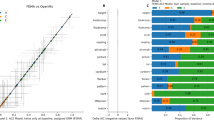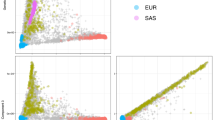Abstract
The genetic and environmental trends in IQ development were assessed in 483 same-sex twin pairs in the Colorado longitudinal twin study using maximum-likelihood model-fitting analysis. The twins were assessed periodically from ages 1 to 16. Results show a decreasing influence of shared environment and an increasing influence of heritability across development, with large and increasing age to age stability of genetic influences. Non-shared environment contributes almost exclusively to age to age change. Similar analyses were conducted designating the top 15% of the sample as having high IQ at each age. The developmental etiology of high IQ did not significantly differ from that found for the continuous measure in this relatively novel analysis. These results demonstrate early stability in etiological influences on IQ and have potential implications for gene-finding efforts, suggesting that samples selected for high IQ can be used to find genetic variation that will be applicable to the full range of the IQ distribution, although conclusive demonstration that the same genes are indeed involved was beyond the scope of this study.



Similar content being viewed by others
References
Akaike H (1987) Factor analysis and AIC. Psychometrika 52:317–332. doi:10.1007/BF02294359
Bailey M, Revelle W (1991) Increased heritability for lower IQ levels? Behav Genet 21:397–404. doi:10.1007/BF01065975
Bartels M, Rietveld MJH, Van Baal GCM, Boomsma DI (2002) Genetic and environmental influences on the development of intelligence. Behav Genet 32:237–249. doi:10.1023/A:1019772628912
Bayley N (1969) Manual for the Bayley scales of infant development. Psychological Corporation, New York
Bishop EG, Cherny SS, Corley R, Plomin R, DeFries JC, Hewitt JK (2003) Developmental genetic analysis of general cognitive ability from 1 to 12 years in a sample of adoptees, biological siblings, and twins. Intelligence 31:31–49. doi:10.1016/S0160-2896(02)00112-5
Boomsma DI, Molenaar PC (1987) The genetic analysis of repeated measures. I. Simplex models. Behav Genet 17:111–123. doi:10.1007/BF01065991
Bouchard TJ, McGue M (1981) Familial studies of intelligence: a review. Science 212:1055–1059. doi:10.1126/science.7195071
Cardon LR, Fulker DW, DeFries JC, Plomin R (1992) Continuity and change in general cognitive ability from 1 to 7 years of age. Dev Psychol 28:64–73. doi:10.1037/0012-1649.28.1.64
Cattell RB (1971) Abilities: their structure, growth, and action. Houghton Mifflin, Boston
Cherny SS, Cardon LR (1994) General cognitive ability. In: DeFries J, Plomin R, Fulker D (eds) Nature and nurture during middle childhood. Blackwell, Oxford
Cherny SS, Cardon LR, Fulker DW, DeFries JC (1992) Differential heritability across levels of cognitive ability. Behav Genet 22:153–162. doi:10.1007/BF01066994
Davis OSP, Arden R, Plomin R (2008) g in middle childhood: moderate genetic and shared environmental influence using diverse measures of general cognitive ability at 7, 9 and 10 years in a large population sample of twins. Intelligence 36:68–80. doi:10.1016/j.intell.2007.01.006
Detterman DK, Thompson LA, Plomin R (1990) Differences in heritability across groups differing in ability. Behav Genet 20:369–384. doi:10.1007/BF01065564
Eaves LJ, Long J, Heath AC (1986) A theory of developmental change in quantitative phenotypes applied to cognitive development. Behav Genet 16:143–162. doi:10.1007/BF01065484
Fulker DW, Cherny SS, Cardon LR (1993) Continuity and change in cognitive development. In: Plomin R, McClearn GE (eds) Nature, nurture, and psychology. American Psychological Association, Washington, DC
Haberstick BC, Smolen A (2004) Genotyping of three single nucleotide polymorphisms following whole genome preamplification of DNA collected from buccal cells. Behav Genet 36:541–547. doi:10.1023/B:BEGE.0000038492.50446.25
Horn JM, Loehlin JC, Willerman L (1982) Aspects of the inheritance of intellectual abilities. Behav Genet 12:479–516. doi:10.1007/BF01073781
Humpreys LG, Davey TC (1988) Continuity in intellectual growth from 12 months to 9 years. Intelligence 12:183–197. doi:10.1016/0160-2896(88)90015-3
Jensen AR (1987) Twins: the puzzle of non-genetic variance. Paper presented at the 17th annual meeting of the Behavior Genetics Association, Minneapolis
Jinks JL, Fulker DW (1970) Comparison of the biometrical genetical MAVA and classical approaches to the analysis of human behavior. Psychol Bull 73:311–349. doi:10.1037/h0029135
Joreskog KG (1970) Estimation and testing of simplex models. Br J Math Stat Psychol 23:121–145
McGue M, Bouchard TJ Jr, Iacono WG, Lykken DT (1993) Behavioral genetics of cognitive ability: a life-span perspective. In: Plomin R, McClearn GE (eds) Nature, nurture, and psychology. American Psychological Association Press, Washington, DC, pp 59–76
Muthén LK, Muthén BO (1998) Mplus user’s guide. Muthén and Muthén, Los Angeles
Neale MC, Eaves LJ, Kendler KS (1994) The power of the classical twin study to resolve variation in threshold traits. Behav Genet 24:239–258. doi:10.1007/BF01067191
Petrill SA, Saudino K, Cherny SS, Emde RN, Fulker DW, Hewitt JK et al (1998) Exploring the genetic and environmental etiology of high general cognitive ability in fourteen to thirty-six month-old twins. Child Dev 69:68–74
Petrill SA, Lipton PA, Hewitt JK, Plomin R, Cherny SS, Corley R et al (2004) Genetic and environmental contributions to general cognitive ability through the first 16 years of life. Dev Psychol 40:805–812. doi:10.1037/0012-1649.40.5.805
Rhea SA, Gross AA, Haberstick BC, Corley RP (2006) Colorado twin registry. Twin Res Hum Genet 9:941–949. doi:10.1375/twin.9.6.941
Ronald A, Spinath FM, Plomin R (2002) The aetiology of high cognitive ability in early childhood. High Abil Stud 13:103–114. doi:10.1080/1359813022000048761
Schmitz S, Cherny SS, Fulker DW (1998) Increase in power through multivariate analysis. Behav Genet 28:357–363. doi:10.1023/A:1021669602220
Skodak M, Skeeis HM (1949) A final follow-up on one hundred adopted children. J Genet Psychol 75:84–125
Spinath FM, Ronald A, Harlaar N, Price TS, Plomin R (2003) Phenotypic ‘g’ early in life: on the etiology of general cognitive ability in a large population sample of twin children aged 2 to 4 years. Intelligence 31:195–210. doi:10.1016/S0160-2896(02)00110-1
SPSS for Windows, Rel. 15.0 (2005) SPSS Inc, Chicago
Sundet JM, Eliertsen DE, Tambs K, Magnus P (1994) No differential heritability of intelligence test scores across ability levels in Norway. Behav Genet 24:337–339
Sweetland JD, Reina JM, Tatti AF (2006) WISC-III verbal/performance discrepancies among a sample of gifted children. Gift Child Q 50:7–10
Terman LM, Merrill MA (1973) Stanford-Binet intelligence scale: 1972 norms edition. Houghton-Mifflin, Boston
Thompson LA, Detterman DK, Plomin R (1993) Differences in heritability across groups differing in ability, revisited. Behav Genet 23:331–336
Vogler GP, DeFries JC (1983) Linearity of offspring-parent regression for general cognitive ability. Behav Genet 13:355–360
Wechsler D (1991) Manual for the Wechsler Intelligence Scale for Children, 3rd edn. The Psychological Corporation, San Antonio, TX
Wechsler D (1997) Wechsler Adult Intelligence Scale, 3rd edn (WAIS-3®). Harcourt Assessment, San Antonio, TX
Wechsler DL (1974) Examiner’s manual: Wechsler intelligence scale for children-revised. Psychological Corporation, New York
Wilkinson SC (1993) WISC-R profiles of children with superior intellectual ability. Gift Child Q 37:84–91
Acknowledgments
Recruitment and data collection for the longitudinal twin sample was funded by NIH grants HD010333, HD18426, MH043899, and a grant from the John D. and Catherine T. MacArthur Foundation. The John Templeton Foundation provided support for Angela Brant through the Consortium on the Genetics of High Cognitive Ability.
Author information
Authors and Affiliations
Corresponding author
Additional information
Edited by Robert Plomin.
Rights and permissions
About this article
Cite this article
Brant, A.M., Haberstick, B.C., Corley, R.P. et al. The Developmental Etiology of High IQ. Behav Genet 39, 393–405 (2009). https://doi.org/10.1007/s10519-009-9268-x
Received:
Accepted:
Published:
Issue Date:
DOI: https://doi.org/10.1007/s10519-009-9268-x




